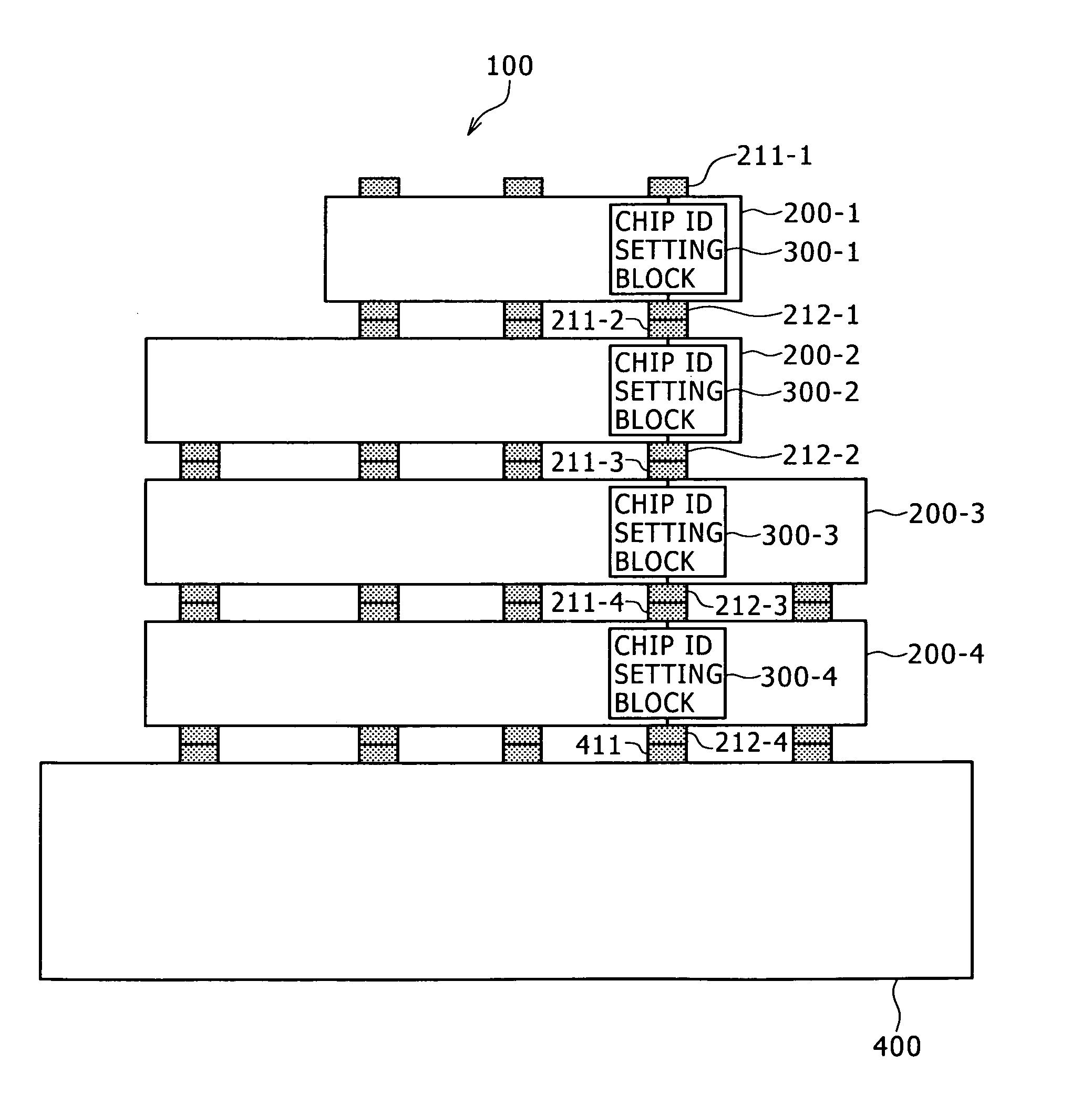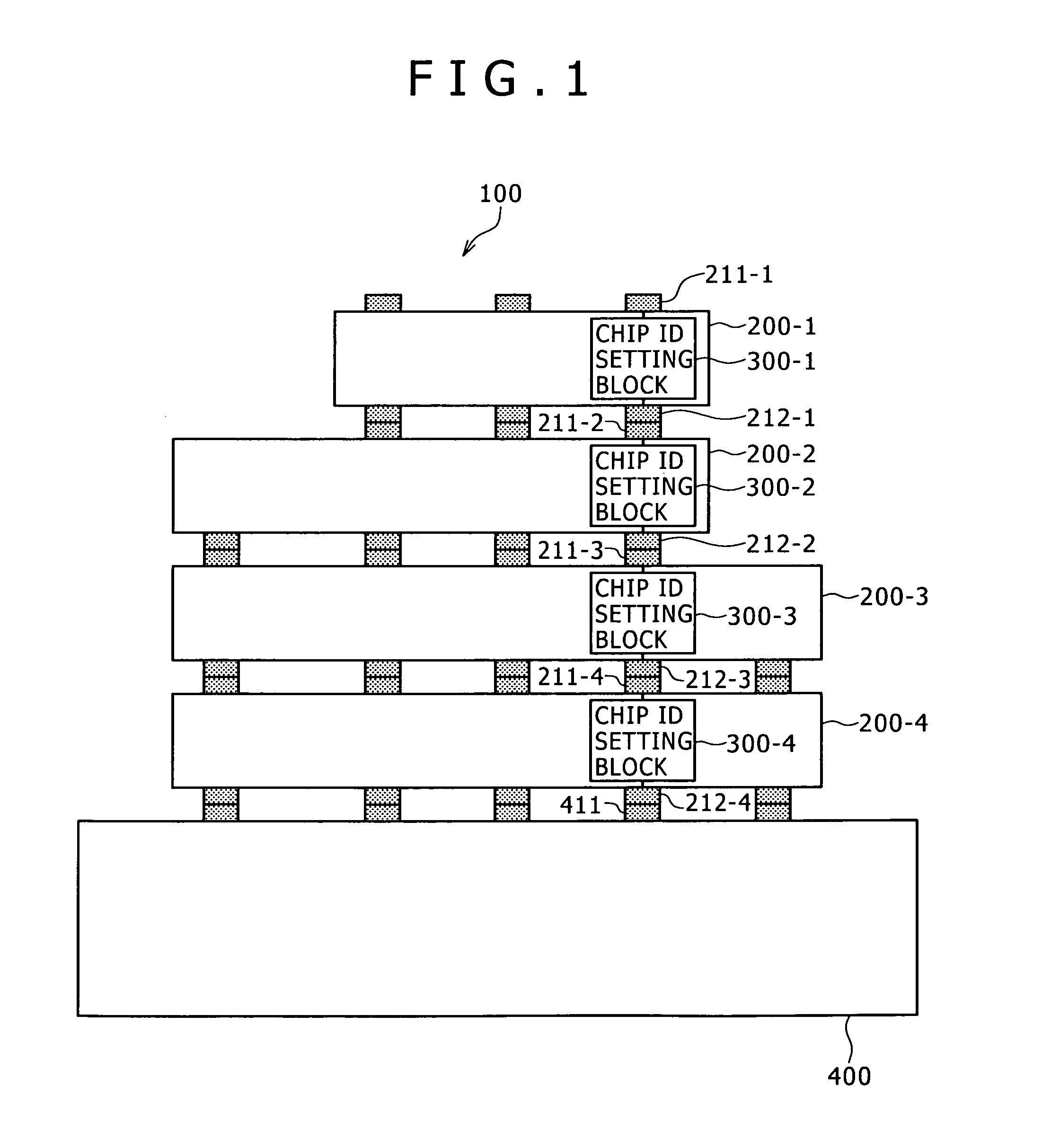Semiconductor device and multilayer semiconductor device
a semiconductor and semiconductor technology, applied in the field of semiconductor devices, can solve the problems of not being able to allocate consecutively numbered chip identifiers to different semiconductor chips, complicating circuit configuration, and ensuring the setting of chip identifiers, etc., and achieve excellent effects
- Summary
- Abstract
- Description
- Claims
- Application Information
AI Technical Summary
Benefits of technology
Problems solved by technology
Method used
Image
Examples
first embodiment
(1) First Embodiment
An Overall Configuration of a Multilayer Semiconductor Device
[0047]Now, referring to FIG. 1, there is shown an exemplary configuration of a multilayer semiconductor device 100 practiced as the first embodiment of the disclosure. The multilayer semiconductor device 100 shown in the figure has a structure in which chips 200-1, 200-2, 200-3, and 200-4 and a base chip 400 are layered from top to bottom in this order. The chips 200-1 to 200-4 are semiconductor chips each having a predetermined function. It should be noted that the chips 200-1 to 200-4 have not especially a common structure; namely, these chips have different structures in accordance with the functions assigned thereto.
[0048]The base chip 400 is arranged at the bottom of the multilayer semiconductor device 100. Signals for controlling the chips 200-1 to 200-4 are outputted from the base chip 400 for example to be transmitted to the chips 200-1 to 200-4 via predetermined wires between the chip layers, f...
second embodiment
(2) Second Embodiment
Exemplary Configuration of a Chip Identifier Setting Block
[0089]The following describes the second embodiment of the disclosure. The first embodiment described above provides a basic configuration for assigning consecutive chip identifiers ID in the ascending order from “1” and the shift register block 310 in each chip identifier setting block 300 is a one-bit shift register.
[0090]By contrast, in the second embodiment, the shift register block 310 is configured as a multiple-bit shift register of two or more bits. By use of this configuration, chip identifiers ID are set to each chip 200 as with the first embodiment and data indicative of the content of predetermined information associated with the each chip 200 is transmitted to the base chip 400 (refer to FIG. 1). It should be noted that the data indicative of the content of predetermined information associated with each chip 200 is hereafter referred to as chip-associated data.
[0091]The above-mentioned chip-a...
third embodiment
(3) Third Embodiment
Exemplary Configuration of the Chip
[0121]The following describes the third embodiment of the disclosure. For the chip 200 corresponding to the third embodiment, a chip with a memory block internally installed is assumed, for example. An actual memory block may include a DRAM (Dynamic Random Access Memory), an SRAM (Static Random Access Memory), or a flash memory, for example. It is also assumed that the memory block be formed by one or more memory planes. A memory plane denotes a storage area obtained by logically dividing the memory block. It is also assumed that the size of the memory planes be common to the memory blocks of the chips. It should be noted that the number of memory planes forming a memory block need not be the same between the memory blocks of the chips; that is, different chips 200 may have the different number of memory planes.
[0122]In a multiplayer semiconductor device with the chips 200 layered as described above, access is executed by specif...
PUM
 Login to View More
Login to View More Abstract
Description
Claims
Application Information
 Login to View More
Login to View More - R&D
- Intellectual Property
- Life Sciences
- Materials
- Tech Scout
- Unparalleled Data Quality
- Higher Quality Content
- 60% Fewer Hallucinations
Browse by: Latest US Patents, China's latest patents, Technical Efficacy Thesaurus, Application Domain, Technology Topic, Popular Technical Reports.
© 2025 PatSnap. All rights reserved.Legal|Privacy policy|Modern Slavery Act Transparency Statement|Sitemap|About US| Contact US: help@patsnap.com



